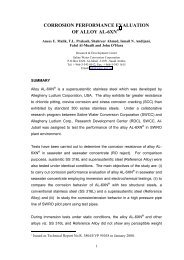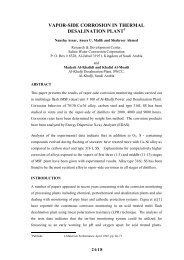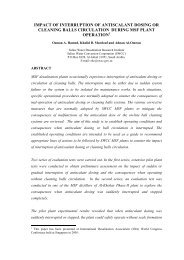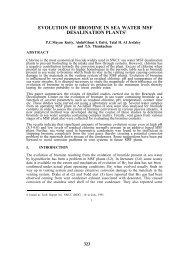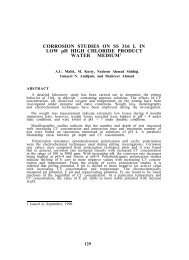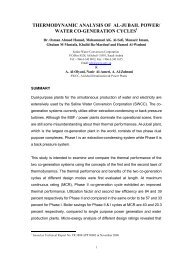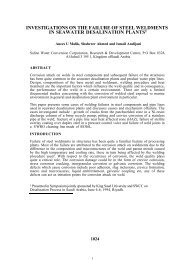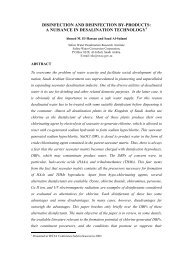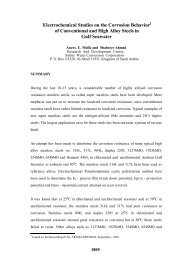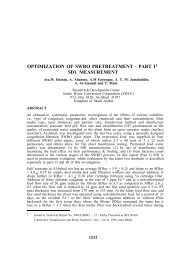quality control of potable water supplies from swcc's
quality control of potable water supplies from swcc's
quality control of potable water supplies from swcc's
Create successful ePaper yourself
Turn your PDF publications into a flip-book with our unique Google optimized e-Paper software.
<strong>from</strong> Al-Jubail and Al-Khafji plants seldom exceeded this limit though lately,<br />
there have been several instances <strong>of</strong> high TDS in the distillates <strong>of</strong> Al-Khobar<br />
plant. In Al-Jubail plant the combined distillates are disinfected with chlorine<br />
gas and then treated with CO2/lime dosing. Both at Al-Khafji and Al-khobar<br />
plants chlorination is done by the addition <strong>of</strong> sodium hypochlorite <strong>from</strong> sea<br />
<strong>water</strong> electrolysers. pH is adjusted by CO2/lime dosing in Al-Khobar. The<br />
pretreated distillates <strong>from</strong> Al-Jubail and Al-Khobar plants are blended with<br />
good <strong>quality</strong> brackish well <strong>water</strong> to upgrade the mineral contents in several<br />
blending station facilities located near the respective distribution centers. Al-<br />
Khafji does not have blending facility due to the absence <strong>of</strong> good <strong>quality</strong> ground<br />
<strong>water</strong> nearby. The <strong>potable</strong> <strong>water</strong> available <strong>from</strong> all these facilities are constantly<br />
monitored for residual chlorine, which is <strong>control</strong>led between 0.2 - 0.5 ppm, and<br />
pH in order to make it safe for human consumption and non-corrosive to<br />
equipments and pipings.<br />
Various constituents present in desalination derived <strong>potable</strong> <strong>water</strong> thus<br />
may originate <strong>from</strong> several sources such as carry over in the product dististillates<br />
<strong>from</strong> the plant, treatment chemicals such as CO2, lime, chlorine/hypochlorite<br />
constituents <strong>from</strong> the brackish <strong>water</strong> used for blending, contamination <strong>from</strong> or<br />
reaction products <strong>of</strong> <strong>water</strong> carrying equipments or treatment chemicals etc. A<br />
periodic assessment <strong>of</strong> the <strong>quality</strong> <strong>of</strong> the <strong>potable</strong> <strong>water</strong> thus becomes essential<br />
to ensure its safety for human consumption.<br />
The parameters which are considered to be toxic or have some adverse<br />
effects on human health are listed in Table 1. This table contains nine health<br />
related inorganic constituents besides organic and microbiological parameters<br />
monitored during this study. In general it can be seen that none <strong>of</strong> the samples<br />
tested during the period <strong>of</strong> this study exceeded the guideline values recommended<br />
for any <strong>of</strong> the parameters set by WHO. Cyanide, mercury and selenium were<br />
totally absent in all samples tested. Lead, cadmium and arsenic appeared in few<br />
samples, occasionally. However, their concentrations were found to be negligible<br />
than the WHO guideline values by an order <strong>of</strong> magnitude or more. Presence <strong>of</strong><br />
chromium was more significant than other constituents. This is not surprising<br />
since traces <strong>of</strong> chromium may leach into <strong>water</strong> <strong>from</strong> the stainless steel parts<br />
extensively used in the plant. The concentrations detected are much lower than<br />
the guideline values. Though chromium is well known for its toxicity, traces<br />
<strong>of</strong> chromium intake is considered necessary according to some researches due<br />
to its beneficial effects on glucose metabolism. Nitrate varied <strong>from</strong> 0 - 2.04<br />
and is considerably less than the guide line value <strong>of</strong> 10 ppm.<br />
Among the other inorganic constituents the concentrations <strong>of</strong> fluoride<br />
(F-) in drinking <strong>water</strong> samples require special mentioning. There is no conclusive<br />
evidence to indicate that fluoride is an essential ion for human nutrition.<br />
Extensive studies conducted in U.S., Europe and several other countries indicate<br />
that there is some correlation between dental health and fluoride content in<br />
drinking <strong>water</strong>. In general the data indicate that <strong>water</strong> containing fluoride upto<br />
an optimal concentration <strong>of</strong> 1.5 ppm reduces dental caries especially among<br />
children while higher concentrations result in mottling <strong>of</strong> teeth and dental<br />
fluorosis (30). The concentration <strong>of</strong> fluoride found in various samples analysed<br />
during the present study varied <strong>from</strong> Nil in Al-Khafji to 0.13 mg/L in Qatif<br />
65



